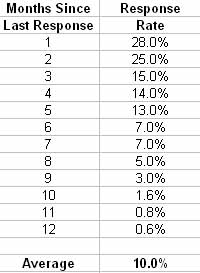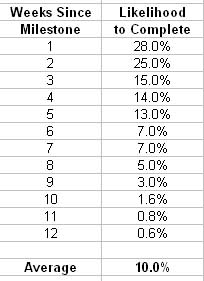Defection Rejection - Part 4
Drilling Down
Newsletter
# 73: 11 / 2006
Drilling Down - Turning Customer
Data into Profits with a Spreadsheet
*************************
Customer Valuation, Retention, Loyalty, Defection
Get the Drilling Down Book!
http://www.booklocker.com/jimnovo
Prior Newsletters:
http://www.drilling-down.com/newsletters.htm
-------------------------------
In This Issue:
# Topics Overview
# Best Customer Retention Articles
# Defection Rejection - Part 4
Topics Overview
Hi again folks, Jim Novo here.
In Part 4 of the Defection Rejection series, we are looking at a reallocation of marketing budget to be more aligned with
customer behavior in B2B and Service businesses. The result is higher marketing
productivity - and credibility in a "more accountability"
world.
We're taking this "productivity approach" to deflect any of
the politics surrounding the whole LifeTime Value / customer retention
mess, putting marketing in a position to help businesses move from a
low accountability to high accountability business model.
Credibility and a seat at the strategic table are why marketing
people should consider these issues -
provided you want credibility and that seat, of course. More on this idea can be
found in a previous newsletter.
We also have some links to relevant articles on the management
issues surrounding this important topic. Turns out many IT folks
out there face these same sorts of issues in the Business Process
Improvement world. Do you suppose the marketing folks and
the IT folks could work on this together? What a beautiful world
that would be...and something Hilton Hotels seems pretty good at.
Let's do the Drillin'!
Best Customer Marketing Articles
====================
Whose
Business is Business Process Improvement Anyway?
November 7, 2006 CIO Magazine
Companies again see business process management (BPM)—the practice of continually optimizing business processes through analysis, modeling and monitoring—as a systematic approach for solving business problems and helping them meet their financial goals.
But who should be in charge, IT or the functional business managers?
You Can Get
to Know Your Guest
November 23, 2006 CRMGuru.com
Wide-ranging interview with Jim VonDerheide of Hilton Hotels covers
increasing marketing productivity in a service business as well as the
interface between marketing and IT.
Questions from Fellow Drillers
=====================
Defection Rejection - Part 3
Last month we looked
at a typical marketing productivity problem in B2C commerce. People generally
look at the overall response rate to a retail campaign instead of breaking
response into meaningful behavioral segments. For example, often
a 10% response rate is distributed like this (a customer can be in
only one segment):

If there is a process with milestones to your business, as is
true to in many B2B situations, the stack above is similar, but
instead of "Months Since Last Response" the title is
"Weeks Since Milestone Passed". You can find the
Average number of weeks between Milestones for your processes, then set
expectations for customer completion of Milestones
based on the average:

As customers pass a Milestone without completing the desired
action, the customer becomes less and less likely to complete the
process, whatever that process is. This means that somewhere in
this stack - and for each Milestone - there is a most profitable
point to trigger an event-based marketing action and get the customer
to complete the Milestone.
As with consumer marketing, in B2B often the "source" of
the new customer - ad campaign, salesperson, trade show- is predictive
of a particular milestone completion pattern. New customers are
what they eat, and often you will find specific parts of the
acquisition process itself are creating defective customers who
fail to complete milestones.
If the problem parts of the process
can't be fixed directly, a "marketing intervention" is
sometimes required to address the fallout from these failures and
extend the life of the customer. For example, specific types of advertising or salespeople trained
by a certain trainer may generate new customers that are less likely
to complete milestones or have an unusual milestone path. The
marketing productivity approach realizes that ultimately, this is a
tremendously wasteful situation and the ads should be rewritten or the
salespeople re-trained to create new customers who are more likely to
complete the milestone sequence or complete it more rapidly. For
this reason, the source of new customers is tremendously important to
track, not only in terms of "conversion", but also over
longer periods in terms of milestone completion.
And, remember that in terms of marketing productivity, often the
higher the response rate, the lower the quality of the customer or
lead acquired. If you create a new campaign that has a higher
than expected response rate, bells should ring and those leads or
customers should be tracked for milestone completion versus the
average new lead or customer.
In service businesses, service events are often handled "in
the moment" without considering the service history of the
customer over time. As customers accumulate events without some
kind of service or marketing intervention, they become less and less likely
to remain a customer:

The tracking of events may also be
"thresholded", as in "3 trouble calls in a month"
or "2 billing errors in a year" or other kinds of
trigger points.
From a marketing productivity perspective, this is tremendously
important information. At some point in this sequence there lies
the most profitable point to take some kind of marketing action to
save the customer. Clearly, the "natural" progression
of the customer's behavior above means the chance of success
trails off rapidly in the out months - if you wait too long to pull
the trigger, your response is going to be weak.
Typically, the most profitable time to take action is where you
seen significant changes in a natural progression like the one
above. In this case, the first occurrence of such a change is at
the third event, where retention likelihood drops from 25% to
15%. This implies some kind of marketing intervention after the
2nd event would probably be most likely to have a profitable
effect. But don't guess - test.
As in the B2B example above, new customer source pays a strong role
in predicting the likelihood a customer will end up going down a poor
service path. This happens because the service expectations of
the customer do not match the actual service experience, and those
expectations are typically set in the new customer sales or marketing
process. Tracking service failure by customer source helps the
marketer hunt down these failures and correcting them, either directly
by changing something on the marketing side or indirectly through a
marketing intervention.
The key in both the B2B and service case above is to act earlier than you have been (if you have been
acting at all), and when you do act, act with more force.
Broadcasting general marketing or service messages to the entire
population is a tremendous waste of time and money, from a marketing
productivity perspective. And "Win Back" is almost
always too late in the cycle and much more expensive than marketing
intervention.
You want to find the place in that stack that generates
the highest level of profitability for marketing interventions in the
sales or service process and hit them hard, with more force. If
you are currently spending $1 per customer annually a year on
facilitating the sales process or broadcasting service messages, use
the "stack" above to find the 20% of customers with highest
likelihood of profitable intervention and test spending $5 on each
customer to maximize impact. This approach increases the
productivity of your marketing spend without increasing your budget;
you can always get more budget later on with proof of success.
Next month, we'll wrap the marketing productivity series up with
some examples of how to take action with this kind of
data.
Jim
-------------------------------
If you are a consultant, agency, or software developer with clients
needing action-oriented customer intelligence or High ROI Customer
Marketing program designs, click
here
-------------------------------
That's it for this month's edition of the Drilling Down newsletter.
If you like the newsletter, please forward it to a friend! Subscription instructions are top and bottom of this page.
Any comments on the newsletter (it's too long, too short, topic
suggestions, etc.) please send them right along to me, along with any
other questions on customer Valuation, Retention, Loyalty, and
Defection here.
'Til next time, keep Drilling Down!
- Jim Novo
Copyright 2006, The Drilling Down Project by Jim Novo. All
rights reserved. You are free to use material from this
newsletter in whole or in part as long as you include complete
credits, including live web site link and e-mail link. Please
tell me where the material will appear.
What would you like to
do now?
Get
the book with Free customer scoring software at:
Booklocker.com
Amazon.com Barnes
& Noble.com
Find
Out Specifically What is in the Book
Learn Customer
Marketing Models and Metrics (site article
list)
|



